《国际经济学》课程教学课件(讲稿)第11章 国际贸易与经济发展 international trade and economic development
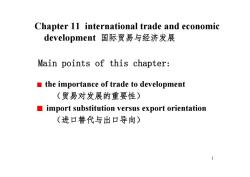
Chapter 11 international trade and economic development国际贸易与经济发展 Main points of this chapter: the importance of trade to development (贸易对发展的重要性) import substitution versus export orientation (进口替代与出口导向)
1 Chapter 11 international trade and economic development 国际贸易与经济发展 Main points of this chapter: the importance of trade to development (贸易对发展的重要性) import substitution versus export orientation (进口替代与出口导向)
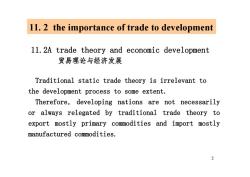
11.2 the importance of trade to development 11.2A trade theory and economic development 贸易理论与经济发展 Traditional static trade theory is irrelevant to the development process to some extent. Therefore,developing nations are not necessarily or always relegated by traditional trade theory to export mostly primary commodities and import mostly manufactured commodities. 2
2 11. 2 the importance of trade to development Traditional static trade theory is irrelevant to the development process to some extent. Therefore, developing nations are not necessarily or always relegated by traditional trade theory to export mostly primary commodities and import mostly manufactured commodities. 11.2A trade theory and economic development 贸易理论与经济发展

11.2C the contribution of trade to development 贸易对发展的贡献 lead to the full utilization of underemployed domestic resources. expand the size of the market,make economies of scale. transmit new technology and new managerial skills. stimulate the international flow of capital from developed to developing nations. ●antimonopoly weapon 3
3 lead to the full utilization of underemployed domestic resources. expand the size of the market, make economies of scale. transmit new technology and new managerial skills. stimulate the international flow of capital from developed to developing nations. antimonopoly weapon 11.2C the contribution of trade to development 贸易对发展的贡献
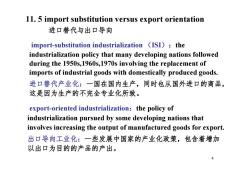
11.5 import substitution versus export orientation 进口替代与出口导向 import-substitution industrialization (ISI:the industrialization policy that many developing nations followed during the 1950s,1960s,1970s involving the replacement of imports of industrial goods with domestically produced goods. 进口替代产业化:一国在国内生产,同时也从国外进口的商品, 这是因为生产的不完全专业化所致。 export-oriented industrialization:the policy of industrialization pursued by some developing nations that involves increasing the output of manufactured goods for export. 出口导向工业化:一些发展中国家的产业化政策,包含着增加 以出口为目的的产品的产出
4 11. 5 import substitution versus export orientation 进口替代与出口导向 import-substitution industrialization (ISI):the industrialization policy that many developing nations followed during the 1950s,1960s,1970s involving the replacement of imports of industrial goods with domestically produced goods. 进口替代产业化:一国在国内生产,同时也从国外进口的商品, 这是因为生产的不完全专业化所致。 export-oriented industrialization:the policy of industrialization pursued by some developing nations that involves increasing the output of manufactured goods for export. 出口导向工业化:一些发展中国家的产业化政策,包含着增加 以出口为目的的产品的产出

main advantages and disadvantages of import-substitution industrialization 优点: ·降低了建立工业取代进口的风险。 ■对发展中国家而言,保护国内市场以抵制外国竞争,比迫 使发达国家降低贸易壁垒允许其出口制造品更容易。 ·为避免进口关税,外国厂商可能在发展中国家投资建厂 (tariff factories关税工厂),增加就业机会。 "有利于改善发展中国家的国际贸易条件(terms of trade)。 缺点: ■国内企业习惯于无国外竞争的环境,缺乏提高效率的动力。 ■许多发展中国家市场小,不能利用规模经济的优势,进口替代 导致产业效率低。 ■在初级制造品被国内生产取代后,进口替代变得越来越困难且 成本高(由于保护程度高,效率低)。 5
5 优点: 降低了建立工业取代进口的风险。 对发展中国家而言,保护国内市场以抵制外国竞争,比迫 使发达国家降低贸易壁垒允许其出口制造品更容易。 为避免进口关税,外国厂商可能在发展中国家投资建厂 (tariff factories关税工厂),增加就业机会。 有利于改善发展中国家的国际贸易条件(terms of trade)。 main advantages and disadvantages of import-substitution industrialization 缺点: 国内企业习惯于无国外竞争的环境,缺乏提高效率的动力。 许多发展中国家市场小,不能利用规模经济的优势,进口替代 导致产业效率低。 在初级制造品被国内生产取代后,进口替代变得越来越困难且 成本高(由于保护程度高,效率低)
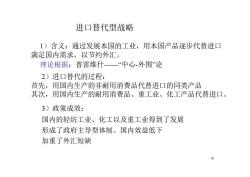
进口替代型战略 1)含义:通过发展本国的工业,用本国产品逐步代替进口 满足国内需求,以节约外汇。 理论根据:普雷维什一“中心-外围”论 2)进口替代的过程: 首先,用国内生产的非耐用消费品代替进口的同类产品 其次,用国内生产的耐用消费品、重工业、化工产品代替进口。 3)政策成效: 国内的轻纺工业、化工以及重工业得到了发展 形成了政府主导型体制、国内效益低下 加重了外汇短缺 6
6 进口替代型战略 1)含义:通过发展本国的工业,用本国产品逐步代替进口 满足国内需求,以节约外汇。 理论根据:普雷维什——“中心-外围”论 2)进口替代的过程: 首先,用国内生产的非耐用消费品代替进口的同类产品 其次,用国内生产的耐用消费品、重工业、化工产品代替进口。 国内的轻纺工业、化工以及重工业得到了发展 形成了政府主导型体制、国内效益低下 加重了外汇短缺 3)政策成效:
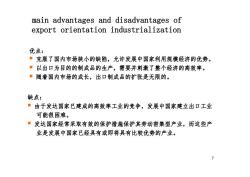
main advantages and disadvantages of export orientation industrialization 优点: ■克服了国内市场狭小的缺陷,允许发展中国家利用规模经济的优势。 ■以出口为目的的制成品的生产,需要并刺激了整个经济的高效率。 ■随着国内市场的成长,出口制成品的扩张是无限的。 缺点: ·由于发达国家已建成的高效率工业的竞争,发展中国家建立出口工业 可能很困难。 ■发达国家经常采取有效的保护措施保护其劳动密集型产业,而这些产 业是发展中国家已经具有或即将具有比较优势的产业。 7
7 优点: 克服了国内市场狭小的缺陷,允许发展中国家利用规模经济的优势。 以出口为目的的制成品的生产,需要并刺激了整个经济的高效率。 随着国内市场的成长,出口制成品的扩张是无限的。 main advantages and disadvantages of export orientation industrialization 缺点: 由于发达国家已建成的高效率工业的竞争,发展中国家建立出口工业 可能很困难。 发达国家经常采取有效的保护措施保护其劳动密集型产业,而这些产 业是发展中国家已经具有或即将具有比较优势的产业
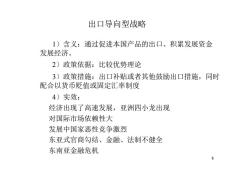
出口导向型战略 1)含义:通过促进本国产品的出口、积累发展资金 发展经济。 2)政策依据:比较优势理论 3)政策措施:出口补贴或者其他鼓励出口措施,同时 配合以货币贬值或固定汇率制度 4)实效: 经济出现了高速发展,亚洲四小龙出现 对国际市场依赖性大 发展中国家恶性竞争激烈 东亚式官商勾结、金融、法制不健全 东南亚金融危机 8
8 出口导向型战略 1)含义:通过促进本国产品的出口、积累发展资金 发展经济。 2)政策依据:比较优势理论 3)政策措施:出口补贴或者其他鼓励出口措施,同时 配合以货币贬值或固定汇率制度 4)实效: 经济出现了高速发展,亚洲四小龙出现 对国际市场依赖性大 发展中国家恶性竞争激烈 东亚式官商勾结、金融、法制不健全 东南亚金融危机
按次数下载不扣除下载券;
注册用户24小时内重复下载只扣除一次;
顺序:VIP每日次数-->可用次数-->下载券;
- 《国际经济学》课程教学课件(讲稿)第10章 经济一体化——关税同盟与自由贸易区 Economic Integration - Customs Unions and Free Trade Areas.pdf
- 《国际经济学》课程教学课件(讲稿)第21章 国际货币体系——过去、现在与未来 the International Monetary System - Past, Present, and Future.pdf
- 《国际经济学》课程教学课件(讲稿)第20章 浮动与固定汇率、欧洲货币体系与宏观经济政策的协调 Flexible versus Fixed Exchange Rates, the European Monetary System, and Macroeconomic Policy Coordination.pdf
- 《国际经济学》课程教学课件(讲稿)第18章 开放经济宏观经济学——调整政策 Open-Economy Macroeconomics - Adjustment Policies.pdf
- 《国际经济学》课程教学课件(讲稿)第17章 收入调节机制与自动调节的综合 the Income Adjustment Mechanism and Synthesis of Automatic Adjustment.pdf
- 《国际经济学》课程教学课件(讲稿)第9章 非关税壁垒与新保护主义 Nontariff Trade Barriers and the New Protectionism.pdf
- 《国际经济学》课程教学课件(讲稿)第8章 国际贸易壁垒——关税 Trade Restrictions - Tariffs.pdf
- 《国际经济学》课程教学课件(讲稿)第7章 经济增长与国际贸易 Economies Growth and International Trade.pdf
- 《国际经济学》课程教学课件(讲稿)第6章 规模经济、不完全竞争和国际贸易 Economies of scale, Imperfect Competition, and International Trade.pdf
- 《国际经济学》课程教学课件(讲稿)第5章 要素禀赋与赫克歇尔-俄林理论(H-O理论)Factor Endowment and the Heckscher-Ohlin Theory.pdf
- 《国际经济学》课程教学课件(讲稿)第4章 供求、提供曲线与贸易条件 Demand and Supply, Offer Curves, and the Terms of Trade.pdf
- 《国际经济学》课程教学课件(讲稿)第3章 国际贸易标准理论 The Standard Theory of International Trade.pdf
- 《国际经济学》课程教学课件(讲稿)第2章 比较优势理论 The Law of Comparative Advantage.pdf
- 《国际经济学》课程教学课件(讲稿)第1章 导论 International Economics(重庆工商大学).pdf
- 《国际经济学》课程授课教案(讲义)国际经济学讲义(萨尔瓦多,英文8版).doc
- 《国际经济学》课程授课教案(讲义)国际经济学讲义(林德特11版).doc
- 《贸易经济学》课程教学课件(PPT讲稿)零售贸易.ppt
- 重庆工商大学:《贸易经济学》课程授课教案(讲义,授课教师:陈淑祥).doc
- 重庆工商大学:《贸易经济学》课程教学大纲 Economics of Trade.doc
- 重庆工商大学:《会计学》课程教学课件(PPT讲稿)第四章 财务会计报告的编制与分析.ppt
- 《国际经济学》课程教学课件(讲稿)第12章 国际资源流动与跨国公司 international resource movements and multinational corporations.pdf
- 《国际经济学》课程教学课件(讲稿)第14章 外汇市场与汇率 Foreign Exchange Markets and Exchange Rates.pdf
- 《国际经济学》课程教学课件(讲稿)第15章 汇率的决定 Exchange Rates Determination.pdf
- 《国际经济学》课程教学课件(讲稿)第16章 可变与固定汇率制下的价格调节机制 the Price Adjustment Mechanism with Flexible and fixed Exchange Rates.pdf
- 《区域经济学》课程教学课件(PPT讲稿)区域经济学导论.ppt
- 《区域经济学》课程教学课件(PPT讲稿)第一讲 区域资源环境.ppt
- 《区域经济学》课程教学课件(PPT讲稿)第七讲 区域要素流动与区际贸易.ppt
- 《区域经济学》课程教学课件(PPT讲稿)第三讲 区域产业结构与产业布局.ppt
- 《区域经济学》课程教学课件(PPT讲稿)第九讲 区域经济发展战略与区域规划.ppt
- 《区域经济学》课程教学课件(PPT讲稿)第二讲 区域经济增长与发展.ppt
- 《区域经济学》课程教学课件(PPT讲稿)第五讲 区域空间结构演进与城乡结构演变.ppt
- 《区域经济学》课程教学课件(PPT讲稿)第八讲 区域竞争与合作.ppt
- 《区域经济学》课程教学课件(PPT讲稿)第六讲 区域城镇体系建设.ppt
- 《区域经济学》课程教学课件(PPT讲稿)第十讲 区域经济政策.ppt
- 《区域经济学》课程教学课件(PPT讲稿)第四讲 区域空间结构理论.ppt
- 重庆工商大学:《西方经济学》课程教学课件(讲稿)第一章 引论.doc
- 重庆工商大学:《西方经济学》课程教学课件(讲稿)第二章 需求曲线和供给曲线概述以及有关的基本概念.doc
- 重庆工商大学:《西方经济学》课程教学课件(PPT讲稿)第三章 消费者行为理论.ppt
- 重庆工商大学:《西方经济学》课程教学课件(PPT讲稿)第四章 生产理论.ppt
- 重庆工商大学:《西方经济学》课程教学课件(PPT讲稿)第五章 成本理论.ppt
